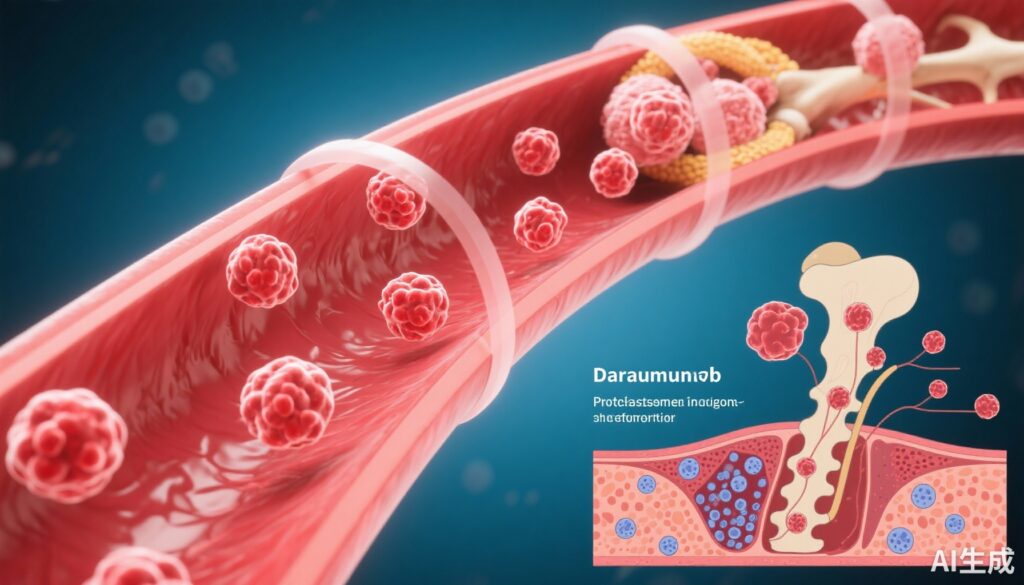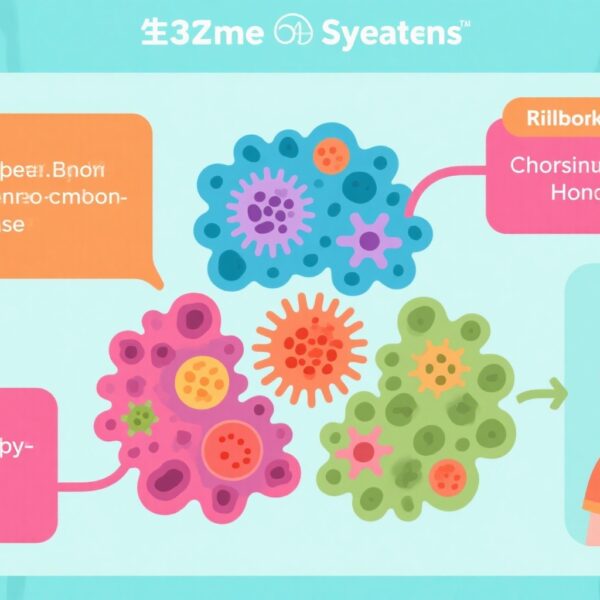Highlight
- Circulating tumor cells (CTCs) were detected in 82% of transplant-eligible newly diagnosed multiple myeloma patients in the phase 3 PERSEUS trial.
- CTC levels independently predicted progression-free survival (PFS) and were associated with minimal residual disease (MRD) negativity rates following treatment.
- Daratumumab combined with bortezomib, lenalidomide, and dexamethasone (D-VRd) improved PFS and MRD-negativity rates compared to standard VRd, especially in patients with low CTC levels.
- High CTC levels identified a high-risk subgroup that benefitted from intensified frontline therapy with improved MRD outcomes.
Study Background
Multiple myeloma (MM) is a hematologic malignancy characterized by clonal plasma cell proliferation in the bone marrow. Despite advances in therapy, prognosis varies significantly based on disease biology and response to treatment. Identification of high-risk biomarkers at diagnosis is crucial to tailor therapy. Circulating tumor cells (CTCs) in peripheral blood represent malignant plasma cells shed from the bone marrow and are emerging as a non-invasive biomarker reflecting tumor burden and aggressiveness. While CTCs have been associated with prognosis in NDMM, their predictive value within the context of novel quadruplet induction regimens incorporating daratumumab for transplant-eligible patients remains to be fully elucidated.
Study Design
The PERSEUS trial (EMN017/NCT03710603) is a phase 3, randomized trial enrolling transplant-eligible patients with newly diagnosed multiple myeloma. Patients were randomized in a 1:1 ratio to receive either the quadruplet regimen of daratumumab with bortezomib, lenalidomide, and dexamethasone (D-VRd) followed by daratumumab/lenalidomide maintenance or the standard triplet VGd regimen (bortezomib, lenalidomide, dexamethasone; VRd) followed by lenalidomide maintenance, both with planned autologous stem cell transplantation.
A subset of 451 patients (231 in D-VRd; 220 in VRd), out of 709 total enrolled, had baseline blood samples processed by flow cytometry to quantify CTC levels. Patients had a median follow-up of approximately 48 months. The primary clinical endpoint was progression-free survival (PFS), with secondary endpoints including minimal residual disease (MRD) negativity rates at sensitivity thresholds of 10^-5 and 10^-6 and sustained MRD negativity.
Key Findings
CTCs were detectable in 82% of patients (370/451) at baseline. The median limit of detection was 0.0004%. CTC level was prognostic for PFS when considered both as a continuous variable (hazard ratio [HR] 1.36, 95% confidence interval [CI] 1.15–1.60; P < 0.001) and as a categorical variable using an optimal threshold of 0.175% to define CTC-high versus CTC-low groups.
Patients with low CTC levels demonstrated significantly improved PFS with D-VRd compared to VRd (4-year PFS rates of 88% vs. 74%, HR 0.42, 95% CI 0.25–0.70; P=0.0013). In contrast, patients with high CTC levels showed a positive trend favoring D-VRd, although statistical significance was not explicitly reported.
MRD negativity rates were consistently lower in CTC-high patients regardless of treatment modality (at 10^-5 sensitivity: 52.2% vs. 66.2%; at 10^-6: 34.8% vs. 52.4%). However, D-VRd significantly increased MRD negativity compared to VRd in both CTC-high (10^-5: 69.4% vs. 33.3%; 10^-6: 47.2% vs. 21.2%; both P < 0.05) and CTC-low groups (10^-5: 74.4% vs. 57.8%; 10^-6: 65.6% vs. 38.5%; both P < 0.001). Similar improvements were observed for sustained MRD negativity.
These findings establish CTCs as an independent prognostic marker in frontline treated transplant-eligible NDMM. The addition of daratumumab to VRd improves PFS and MRD outcomes, particularly in CTC-low patients, and enhances deep and sustained responses even in patients with high baseline CTC burden.
Expert Commentary
The PERSEUS trial’s CTC analysis underscores the clinical utility of liquid biopsy techniques in multiple myeloma to stratify patient risk beyond traditional clinical and cytogenetic factors. Flow cytometric quantification of CTCs offers a minimally invasive and dynamic biomarker that can help identify patients at higher risk of progression who may benefit from intensified or maintenance-directed therapies.
Daratumumab’s immunomodulatory and anti-plasma cell effects likely contribute to improved MRD negativity seen across CTC subgroups. This supports current guidelines advocating for daratumumab-containing quadruplet regimens in transplant-eligible NDMM. However, further studies are needed to evaluate strategies specifically tailored to CTC-high patients, who remain at residual risk despite treatment intensification.
Limitations include the subset analysis nature of CTC testing and absence of detailed overall survival data at this stage. Additionally, standardization of CTC detection and thresholds is necessary for broad clinical implementation.
Conclusion
Circulating tumor cells serve as a robust prognostic biomarker predicting progression-free survival and MRD negativity in transplant-eligible patients with newly diagnosed multiple myeloma undergoing frontline treatment. Integration of daratumumab into the VRd regimen significantly improves outcomes across CTC stratifications, highlighting the importance of integrating novel agents to overcome high-risk disease features. Routine CTC assessment may refine risk stratification and guide personalized therapeutic approaches in MM.
Funding and Clinical Trials Registry
The PERSEUS trial was conducted with support from institutional and cooperative groups within the European Myeloma Network. The clinical trial is registered at ClinicalTrials.gov under the identifier NCT03710603.
References
Bertamini L, Fokkema C, Rodriguez-Otero P, van Duin M, Terpos E, D’Agostino M, van der Velden VHJ, van de Donk NWCJ, Delforge M, Driessen C, Hajek R, Einsele H, Vangsted AJ, Vieyra D, Attar RM, Sitthi-Amorn A, Carson R, Schjesvold F, Robak P, Beksac M, Spencer A, Broijl A, Cupedo T, Moreau P, Boccadoro M, Sonneveld P. Circulating tumor cells predict myeloma outcomes in patients treated with daratumumab, bortezomib, lenalidomide, and dexamethasone. Blood. 2025 Oct 8:blood.2025030113. doi:10.1182/blood.2025030113. Epub ahead of print. PMID: 41060326.



